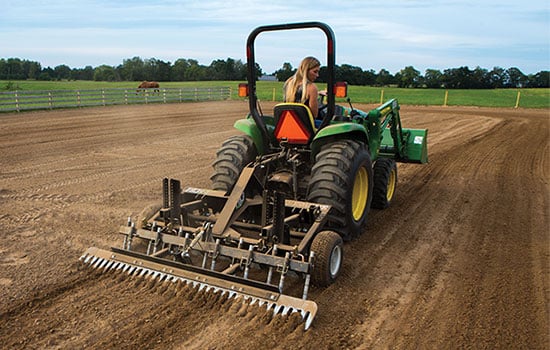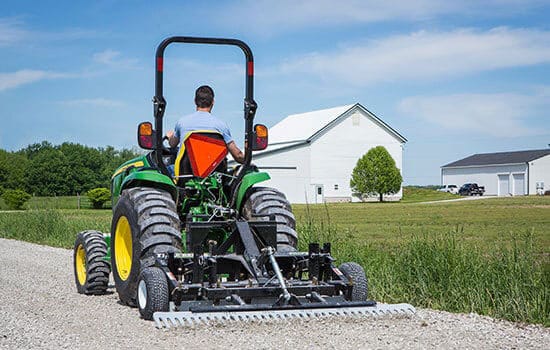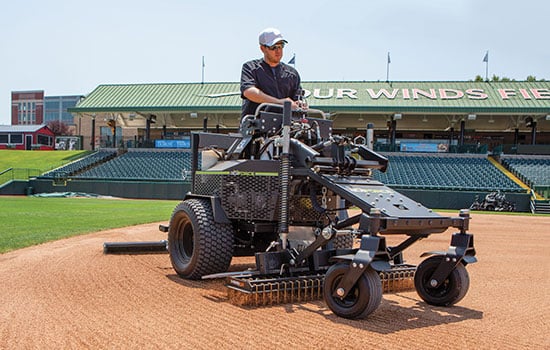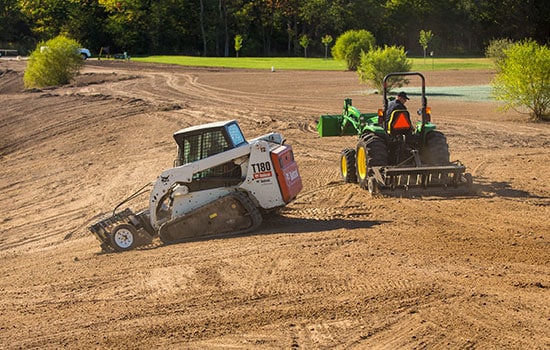TR3 Rake – Arena Renovation
Transcript
My name is Scott Holmes. I’m the Executive Vice President of ABI Equine. We are out at Loveway Therapeutic Riding Center and Middlebury, Indiana today. Helping them with their indoor arena. Now they called us a couple of weeks ago looking for help with their arena footing primarily in arena drag. You know what it would take to loosen a really hard packed riding surface. And we’ll show you this indoor arena that they have here and explain to you kind of the condition that the arenas in the what the footing is like and why we think it got there.
When I came out a couple weeks ago to look at the arena footing and to talk them about arena drags, I noticed that the primary reason this arena has gotten in this condition is because the equipment they’re using. We’re going to talk about that, I would show you the equipment they’ve been using and why it’s created a really hardpan and shallow surface.
Now, this material has quite a bit of stone in it. I wouldn’t call this technically the best arena footing in the world. In fact, I advise them, but they might want to replace it. But today we’re going to loosen the hardpan that the other arena drags and caused reincorporated with some of the loose material, add water to it and bring this arena back to life. I was going to show you a couple examples how hard it is. You can see here with a shovel. This is a really hard packed surface that was only about a half an inch to an inch deep, which is not deep enough for therapeutic riding center. With a therapeutic riding center you want cushion and rebound and you want a comfortable place both for the horse, the rider and the walker beside the horse. So this right here is unacceptable and this is why they call us. But in this arena, you also have areas that are deep and loose. And this is where they work, work the horse and they don’t have a drag that will spread this material around and keep it evenly, evenly mixed. And there are areas where there might be one or two inches, but even this is really hard again. So we’ve just walked across the arena 15 foot and we had a hard, dusty area to a deep, loose area to a really hard, wet area. And that inconsistency just creates problems where the horses are foot fall with the safety of the riders. So we’re gonna take our TR3 rake in here and we’re going to consistently loosen this re level of reincorporate all the material. Then we’re going to add some water to it. Then we’re going to take you out and show you the equipment they were using and why we recommend a different arena drag a maintenance program for this.
Alright. We just came out from the indoor arena and you saw in there that the footing in the arena was very compacted in some spots. It was deep in some spots. It was very inconsistent, It had a lot of undulations and really high spots, really low spots and most importantly, a lot of that material, because it was kind of a granular material, had a lot of dirt or clay content to it. It was really packing down and coming hard like concrete. In fact, it’s it’s what I call a false base. They had the horses had ridden on there for so many years and they had insufficient drags for so many years that had created a false base to where they thought they were out of material. And you’ll see when we go back in the arena, we fixed it how the material is still there. We just brought it back to life with a good arena drag and water.
But I brought you out to their shed and their barn because I will show you the two pieces of equipment that they have been using to groom their footing. And this is what has caused this. This is, you know, I mean, I suppose you could think I’m lying to you. But the fact of the matter is, hopefully I can explain to you why these two pieces of equipment that they’ve used to groom the arena caused the problems they had. The first one is kind of a traditional 3-point chain harrow and chain harrows are designed to go lay flat on the ground and cover a full area of a wide area and loosen the surface. The problem is that the chain harrow is only going to break into the ground an inch, maybe an inch and a half at the most. And most importantly, the problem with the chain harrow is that you have all these points of contact. It’s almost like laying a piece of cardboard on the dirt and pulling it across. You can imagine how all those points of contact would flatten the sand. And this is what happens with the chain harrow that you have all these points of contact coming from the top down and they’re compressing over a wide, you know, four foot by five foot or five foot by five foot area. And as you’re pulling it through the soil and through the material, it’s packing that whole footprint all at one time. So over time, that begins to compress all that material down. And because it chain harrow then doesn’t go very deep as that material gets harder and harder and harder and the in the base or the fall space starts getting closer and closer to the surface. The chain here won’t break into it. So pretty soon you have this smooth as glass, hard as a rock footing surface with just a little skim of a half an inch of material on top. That is traditionally what we see when we see a chain harrow being used in an arena.
I want to show you what they went to after the chain harrow. One of their board members thought he was being a great guy, donated this piece of equipment. He saw it on a commercial at 2 o’clock in the morning, thought, wow, that’s going to solve all of our problems. And what ended up happening was it didn’t do any better than the chain harrow and actually was a waste of twelve hundred dollars. We’re going to take you over, and show you what the call the power grader and I’ll walk you through that.
So after using the chain harrow, they thought like they upgraded to the power grader. And this is the power of grader. And it is a power grader because it has a power unit on the side, a little electric cylinder that’s used to raise and lower the wheels. And that’s that is why they call it a power grader. But it has no moving parts within the tool. It has short little knob teeth on the front. And it’s got a blade that smooths out on the back. And that’s really all there is to it. These little teeth have no chance of getting into a material, has any kind of compaction. If it is a pure wash sand with no fines or no clay, then possibly this could do a job of loosening the surface. But there is no way that this tool is going to break into a hard riding service, a service that has compaction to it, a service that has some fines or clays in it, which you need in order to give a binding factor to give shear strength and a stable footfall. And you can tell this tool did not work for them right off because we’ve not set this up. But you can see they put big boulders on top of the on top of the power grader. And they did it to try to give weight to break up this compaction that I just show you. That did not work. It has not worked. So you have two things that are that are causing a hardpan here. One is you have small little teeth that are just two, you know, riding in and a quarter inch, half an inch. And secondly, you had this blade in the back. That’s just skimming the surface. It’s not a blade that actually gets in and transports material and grades. It’s just a smoother blade. And it is carrying material. And when you carry material on a blade, it compacts and there’s nothing behind it to release loosen that, you know, on our tools after you level, we release loosen and rake because we know that when you pull material on a blade, you compact. Well, in this case, the designs of this tool didn’t understand that. They’re finishing with a smoothing blade, which is just compacting and making a hardpan. So when I got here last week, two weeks ago and they talked me through what they were using. I asked him point blank to these tools work and they said absolutely not. We’ve not been able to make either the chain harrow or this power grader do what we wanted to do. The material is still getting hard. It’s still becoming an unreasonable surface. And we can’t figure out what to do. So we came in today and used our TR3 rake. We used our water wagon to give it moisture after we broke it up and let’s go back to it and see what the results were.
Well, we’ve come back into their indoor arena, I’m standing right in the middle of arena that an hour and a half ago was absolutely unridable. If you remember ahead, hard compaction so, so hard that it was slick. There are areas that were deep and loose and there was not enough moisture in it. And with our TR3 rake and with a 300 pound waterwagon we brought this arena back to life, we were able to knock off the high spots, fill in the low spots, loosen consistently the material and bring back to life a three inch. You see, as I move my foot here, a nice two and a half to three inch footing, that’s got a really nice consistency and consistency to it, a nice heaviness. This material right here is going to hold up a twelve hundred pound animal. The footfall is not going to slide forward, go backwards, go side to side. This material is going to create a really nice riding surface for both the horse and the rider, and they cannot make it happen with the tools that we’re using. And we came in here in an hour and a half and turned a unusable surface into a really nice riding arena.



